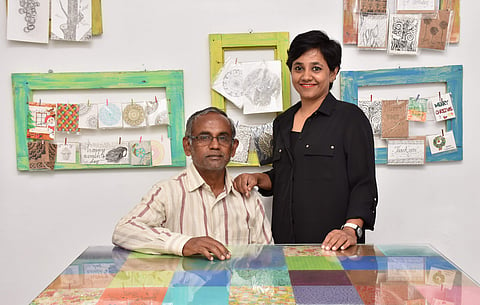

Back in school, I could never even remotely be associated with being an artist or loving colours for that matter, but I loved Arts and Crafts period because it was a relatively ‘easy’ period where I could just pretend to do work but chill, and safely pack the colour papers and confetti to take home at the end of the hour. Why take the raw materials home, you may ask. Well, that’s because my dad was an expert in cutting and pasting stuff. And honestly, all the ‘crafty’ things I have created were never mine, they were his handiwork. There, I said it! I got ‘A’ grades in Art only because of my dad’s kindness.
Like me, Ishwarya Subramanian also worked with her father on many artistic projects but unlike me, she can call herself an excellent artist because she actually collaborated with her dad and didn't piggy-back off his talent. Being an architect, she decided to combine her love for art and architecture and with her father, K Subramanian, she started her very own art studio, MystiQ in Coimbatore. A specialist in interior designing, Ishwarya designed and set up the studio using recycled products she bought from a scrap vendor. Her father, a retired Central Public Works Department official, who used to find a little time here and there for his creative pursuits earlier, now completely dedicates his time to creating artistic wonders at MystiQ.
Most of their works, which include décor such as clocks and fridge magnets, feature lines of different shapes and sizes manipulated in different ways — a technique called 'tangling' that has gained popularity in recent times. The father-daughter duo’s products are gaining popularity not only all across South India but also foreign countries such as the UK. Excerpts from the interview:
1. How is tangling different from doodling?
Ishwarya: Both are derived from line art. Tangling follows a fixed format when compared to doodling. Their styles also differ but often, both the terms are used interchangeably. Before taking up architecture, I used to call my artwork doodling too. There are minor differences between the two.
2. Can you tell us more about your products?
Ishwarya: We make bookmarks, fridge magnets, coasters, customised clocks, trays and much more. Every artwork of mine has its base in lines. Another major thing I do is mandalas. People think it is a different form of art but again, its basis lies in line art. But mandala involves drawing lines in radial symmetry to form a circle.
3. How does being an architect help you as an artist?
Ishwarya: To be honest, it took me ages to understand that I have an innate, inexplicable bond with lines. Architecture helped me in not only discovering that bond, but also strengthening it. I would call myself a designer, rather than an architect. Whatever I learnt in Architecture, I use now in my art.
4. We have seen father-daughter duos in music and other performing arts. Why did you both decide to give it a try in art?
Ishwarya: Well, it was my father who pushed me into making a profession out of a passionate hobby. When I was designing décor for a café at Rasipuram, the idea struck me — why not do this with my dad as he is also an artist. That’s how we started out. It is fun to work with my dad; we tell people that we are colleagues. (giggles)
5. Working with friends is different from working with your dad, so in your case, what's the dynamics like? Who suggests the ideas?
Ishwarya: We don't work together. We sit together only when we are packing stuff or something like that. We comment on each other's work. Both of us don't listen to each other. (she laughs) You can easily differentiate my work from his.
Subramanian: We have noticed that it is difficult to work together. While creating art, you create a sacred space for yourself and you cannot allow anybody to enter that, be it your friend or daughter.
6. Which of your products is the most difficult to make?
Ishwarya: Making clocks is a complicated task because even a small flaw in the centre point of the clock can lead to the entire thing going to waste. The person who makes the clock has to be very careful while framing it or else we are answerable to the client. Usually, there is no issue with the drawing or prototype as such; other small, miscellaneous things lead to complications.
7. Do you carry your work home or is it a 'studio-only' affair?
Subramanian: In this work, you cannot restrict yourself to certain spaces only as this deals with ideas and creativity. You can get a new idea or technique spontaneously, out of the blue. So, this is 24x7 work, whether you are at home or at the studio.
8. Does doodling or tangling help to overcome stress?
Ishwarya: I believe that any form of art is therapeutic. It depends on the person who is practising it. Unless they are interested in it, it's not going to help them out. Just keep drawing lines in a notebook continuously and you will feel calm; it will help you be at peace with yourself. Lines have a very good impact, I believe, as they exude positive energy.
9. What are your future prospects?
Ishwarya: I want MystiQ to become a signature brand. I am trying to incorporate these designs into my architecture projects as well. I am a great fan of Charles Rennie Mackintosh, a Scottish architect. Mackintosh not only designed the place, but also designed the cutlery which goes with that space. He is my inspiration — both as an architect and as an artist.
